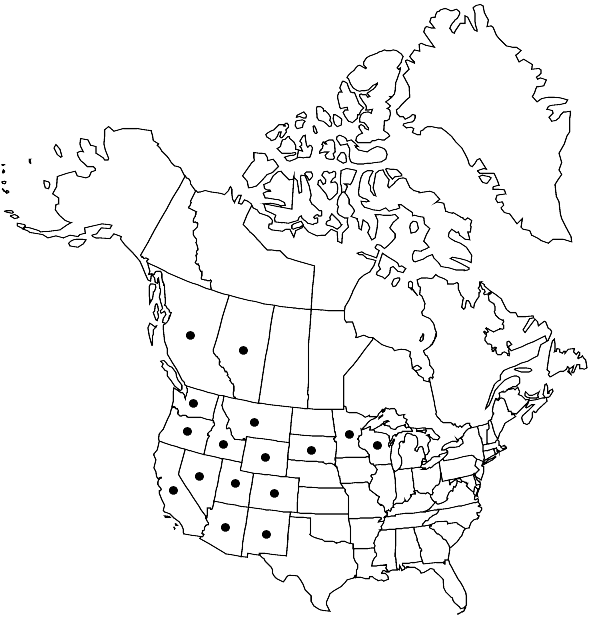Coscinodon calyptratus
in N. C. Kindberg, Eur. N. Amer. Bryin. 2: 241. 1897,.
Plants 7–10 mm, olivaceous. Leaves ovate to ovatelanceolate, 1.4–2.4 × 0.4–0.7 mm, margins plane or one margin recurved at mid leaf, apex plane, awn 0.4–1.4 mm, lamina non-plicate; basal juxtacostal laminal cells long-rectangular, 15–80 × 7–10 µm, evenly thin-walled; basal marginal laminal cells quadrate to long-rectangular, 16–60 × 7–15 µm, thin or thick end walls and thin lateral walls; medial laminal cells 1-stratose; distal laminal cells 1-stratose. Sexual condition autoicous. Seta 1.4–2.4 mm. Capsule exserted, cylindric, commonly constricted at rim; peristome present, solid, xerocastique.
Habitat: Most common on dry sandstone and granitic boulders and bedrock exposures but also limestone and volcanic outcrops
Elevation: moderate to high elevations (300-3000 m)
Distribution

Alta., B.C., Ariz., Calif., Colo., Idaho, Minn., Mont., Nev., N.Mex., Oreg., S.Dak., Utah, Wash., Wis., Wyo.
Discussion
Coscinodon calyptratus is common and widespread in the dry interior mountain areas of western North America. To the east it is largely bounded by the front ranges of the Rocky Mountains and acidic outliers such as the Black Hills of South Dakota. Two disjunct sites in Wisconsin and Minnesota define the eastward extent of the species. It is not found along the west coast mountains. Specimens from central Asia and New Zealand attributed to this North American endemic by J. Muñoz (1998c) instead represent an undescribed species of Coscinodon and a Grimmia. The non-plicate, 1-stratose leaves with plane or one revolute margin, and exserted capsule clearly separate this species from all other North American Coscinodon. The autoicous sexual condition is unique in the genus but often difficult to ascertain on any particular specimen. This species is more commonly confused with G. longirostris (formerly G. affinis) than with any other Coscinodon. Both species are autoicous, have a similar robust habit, have leaves that are strongly keeled and may have recurved margins, and have long-exserted capsules. If fertile and with capsules, the species are easily distinguished, as C. calyptratus has large, plicate calyptra and has a thin-walled filmy annulus. In contrast, G. longirostris has smaller, smooth calyptra and a large, prominent annulus. Gametophytically, C. calyptratus has 1-stratose areolation across the distal and medial lamina except for a 2-stratose margin. Its basal cells tend to be evenly thin-walled. Grimmia longirostris has a 2-stratose distal lamina and a wide 2-stratose margin at mid leaf. Its basal cells tend to be thicker walled.
Selected References
None.